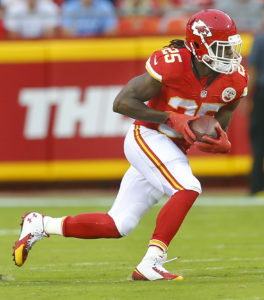KANSAS CITY, Mo. — Speed is one of those attributes that the National Football League spends millions of dollars each year to find, develop and cultivate.
Every coach in the NFL, no matter his expertise or position, has said at least once in his career that “speed kills.”

Aug. 21, 2015; Kansas City, MO; Chiefs running back Jamaal Charles (25), wide receiver Jeremy Maclin (19) and running back Knile Davis (34) before the preseason game against the Seattle Seahawks at Arrowhead Stadium. (Chris Neal/The Topeka Capital-Journal)
The idea of how fast a young man can run 40 yards in his shorts is often over-rated. One of the best players in league history was wide receiver Jerry Rice; he never cracked 4.5 seconds in the 40-yard dash. For the ordinary person, running under 4.5 is a monumental achievement. Among athletes and football players, it’s considered average.
But speed combined with top-shelf athletic ability can make the difference between victory and defeat.
This year, Andy Reid and his coaching staff have more speed available to them on offense that any team in the history of the Chiefs franchise. From rookie wide receiver Chris Conley to second-year receiver Albert Wilson, there are six eligible receivers that have broken 4.5 seconds in the 40, and five that broke 4.4 seconds.
One of the season’s biggest questions remains how Reid and his offensive staff use the speed they’ve accumulated.
“I think we’re a little bit faster than we were last year, but we’ll see,” Reid said. “We’ll see when it really gets going and you’ve got speed against speed in a real game and we’ll see how that works. But right now I would tell you that it looks like we are a little bit faster.”
Here is the offensive speed the Chiefs can put on the field for the coming season, ranked by their 40-yard dash time coming into the league. PD represents timing from the player’s Pro Day workout and C stands for the NFL Combine:
- Wide receiver Chris Conley: 4.23 seconds (PD).
- Wide receiver Jeremy Maclin: 4.31 seconds (PD).
- Wide receiver De’Anthony Thomas: 4.34 seconds (PD).
- Running back Jamaal Charles: 4.36 seconds (PD).
- Running back Knile Davis: 4.37 seconds (C).
- Wide receiver Albert Wilson: 4.43 seconds (C).
That’s four receivers and two backs that have all broken 4.5 seconds.
For an offensive coaching staff and a play caller like Reid, there are many combinations that Reid can be utilized with the five eligible receiving spots on each play. And, that doesn’t include the team’s leading receiver last year, tight end Travis Kelce.
“When you’ve got fast guys you’ve got to call it fast,” Reid said with a chuckle. “But it does give you an opportunity to stretch the field a little bit more.”
The last time the Chiefs offense could field that type of speed was in the 2002 through 2004 seasons when the Dick Vermeil offense was using the speed of running backs Priest Holmes (4.38) and Derrick Blaylock (4.36) and wide receivers Eddie Kennison (4.4), Dante Hall (4.42) and Marc Boerigter (4.47). Those teams proved to be the most prolific offense in club history.
Speed and stretching the field “a little bit more” does not just translate into more long passes. If speed can push the back line of the defensive coverage further down the field, it opens up short and intermediate routes. It’s a domino effect that leads to offensive yards, big plays and touchdowns.
That’s just the tonic the Chiefs offense needs for the 2015 season. They were No. 25 in the NFL in offensive yards per game (318.8), No. 29 in net offensive passing yards per game (198.9) and No. 18 in offensive touchdowns (36.)

Aug. 21, 2015; Kansas City, MO; Chiefs running back Jamaal Charles runs the ball during the first half of preseason action against the Seattle Seahawks at Arrowhead Stadium. (Chris Neal/The Topeka Capital-Journal)
“You just can’t teach speed; it’s a factor that has to be respected,”quarterback Alex Smith said. “When you have guys on the field who can run, you see it; you see the respect that it gets.
“It opens up a lot of things. You certainly want to be able to stretch the field a lot of different ways; when you have a guy that can do it faster, that’s even better. Obviously the quicker you can do it, the better. There is give-and-take between holding onto the football and stretching the field.”
Reid and his staff can open up parts of the playbook that they weren’t able to use last year.
They can leave an empty backfield with five potential receivers that can press the defense. At various times during training camp practices, they showed three-wide receiver sets featuring Maclin, Wilson and Thomas, with Charles and Kelce also on the field.
That group does not include possibly the fastest player in Conley, or Davis, who had the longest pass play last season for the Chiefs with a 70-yard score.
“I’m very aware of the guys stepping in the huddle – all five guys are very capable of making plays that are going to touch the football,” Smith said. “On any given play, it’s just trying to find that matchup that you feel good about. You feel good just letting your reads take over. We have a lot of guys who can make plays.”
It’s not as simple as throwing a relay quartet from the world of track on the field. A player is timed in the 40-yard dash while wearing shorts, no pads and no helmet. Plus, there is no one chasing him and he does not have to worry about holding onto a football. Generally, the turf and weather are very good when timing for the 40 takes place, sometimes those conditions do not always appear on the field of play.
There are a handful of sprinters that became successful football players, topped by Bob Hayes, Olympic gold medalist in the 100 meters in the 1964 Summer Olympic Games in Tokyo. He ran 10.06 seconds and at one time or another held world records for the 60, 100 and 200-yard dashes, as well as the 100 and 200 meters. He played 11 seasons, catching 371 passes for 7,414 yards and 71 touchdowns in 132 games.
A few others had successful careers in pro football including Willie Gault (Bears and Raiders) and Michael Bates (Seahawks and Panthers).
———-
Bob Gretz is the senior editor for ChiefsDigest.com. Use the contact page to reach him or find him on Twitter: @BobGretzcom.
———-
